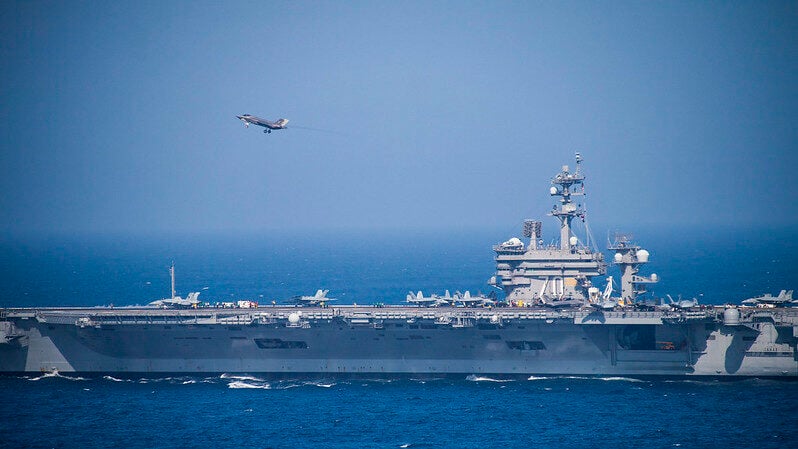
An F-35C takes off from the USS Carl Vinson. (File)
WASHINGTON: The Senate’s proposed move to cut $84 million from the Navy’s 2021 $482 million budget request for incremental upgrades to its F-35C fighter jets will push back critical electronic warfare capabilities by a year and decrease operational availability, according to the service’s budgetary appeal obtained by Breaking Defense.
It also will end up increasing costs for retrofitting the EW hardware into the service’s Joint Strike Fighter variant by $700 million, the service argues.
Senate appropriators in their version of the annual defense spending package, released last month, criticized the overarching Joint Strike Fighter software/hardware upgrade plan, called Continuous Capability Development and Delivery (C2D2). Under the C2D2 program, prime contractor Lockheed Martin is supposed to deliver software upgrades every six months. However, the Government Accountability Office (GAO) in a July report found that those upgrades were more often than not delayed, and it criticized the Pentagon’s Joint Program Office (JPO) for failing to develop a more realistic schedule.
The JPO requested a total of $1.98 billion for C2D2 for Air Force, Navy and Marine Corps jets, but the Senate Appropriations Committee (SAC) would slash $565.9 million from the total.
Echoing GAO’s concerns about unrealistic scheduling and vague performance criteria, the appropriators cited “significant challenges” to the effort including: “cost growth of approximately 70 percent, schedule delays of the Technology Refresh 3 system, and a 3 year delay in the delivery of the complete Capability Increment #1 (formerly Block 4) capabilities.”
The SAC added, “Given that F–35 modernization is planned using the C2D2 approach through 2035, the Committee is troubled by these developments.”
Further, the appropriators noted the high costs of the total C2D2 effort, and charged the Defense Department to break it out into a stand-alone major acquisition program in its 2023 budget to allow greater transparency and improved oversight.
For it’s part, the Navy cited a litany of woe beyond that would befall the F-35 program writ large if its funding for C2D2 is slashed.
“Proposed program reductions will cause significant negative impacts to the development, delivery, and fielding of important electronic warfare, radar, communications, precision navigation, and integrated weapons capabilities on the F-35 (inclusive of critical F-35 Training Systems). These capabilities are required by the F-35 warfighter to meet the challenges of a rapidly evolving global threat environment, and are critical to keeping F-35 dominance over our near-peer competitors, China and Russia,” the document argued.
For the Navy in particular, this includes “a one-year delay of U.S. Service prioritized weapons integration and associated mission planning activities including AARGM-ER, the AGM-158 family of weapons, and increased missile carriage negatively impacting F-35 survivability and lethality,” the appeal said.
Finally, the Navy argued that the SAC reduction would have a “significant negative impact” on the JPO’s effort to replace Lockheed’s infamously complicated and buggy maintenance and logistics software, ALIS (for Autonomic Logistics Information System), with a faster, streamlined version. The new software, called ODIN, for Operational Data Integrated Network, is being developed internally by DoD to give service maintenance efforts more autonomy.
In a ‘world first,’ DARPA project demonstrates AI dogfighting in real jet
“The potential for machine learning in aviation, whether military or civil, is enormous,” said Air Force Col. James Valpiani. “And these fundamental questions of how do we do it, how do we do it safely, how do we train them, are the questions that we are trying to get after.”


























